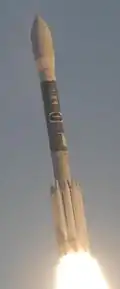N-II (rocket)
The N-II or N-2 was a derivative of the American Delta rocket, produced under licence in Japan. It replaced the N-I-rocket in Japanese use. It used a Thor-ELT first stage, a Delta-F second stage, nine Castor SRMs, and on most flights either a Star-37E or Burner-2 upper stage, identical to the US Delta 0100 series configurations. Eight were launched between 1981 and 1987, before it was replaced by the H-I, which featured Japanese-produced upper stages. All eight launches were successful.
 The N-II rocket | |
| Function | Carrier rocket |
|---|---|
| Manufacturer | McDonnell Douglas (design) Mitsubishi Heavy Industries (production) |
| Country of origin | United States (design) Japan (production) |
| Size | |
| Height | 35 metres (115 ft) |
| Diameter | 2.44 metres (8.0 ft) |
| Mass | 132,690 kilograms (292,530 lb) |
| Stages | 2 or 3 |
| Capacity | |
| Payload to LEO | |
| Mass | 2,000 kilograms (4,400 lb) |
| Payload to GTO | |
| Mass | 730 kilograms (1,610 lb) |
| Associated rockets | |
| Family | Delta |
| Launch history | |
| Status | Retired |
| Launch sites | LA-N, Tanegashima |
| Total launches | 8 |
| Success(es) | 8 |
| First flight | 11 February 1981 |
| Last flight | 19 February 1987 |
| Boosters – Castor 2 | |
| No. boosters | 9 |
| Engines | 1 TX-354-3 |
| Thrust | 258.9 kilonewtons (58,200 lbf) |
| Specific impulse | 262 sec |
| Burn time | 37 seconds |
| Fuel | Solid |
| First stage – Thor-ELT | |
| Engines | 1 MB-3-3 |
| Thrust | 866.7 kilonewtons (194,800 lbf) |
| Specific impulse | 290 sec |
| Burn time | 270 seconds |
| Fuel | RP-1/LOX |
| Second stage – Delta-F | |
| Engines | 1 AJ-10-118F |
| Thrust | 41.3 kilonewtons (9,300 lbf) |
| Specific impulse | 280 sec |
| Burn time | 335 seconds |
| Fuel | HNO3/UDMH |
| Third stage (optional) – Star-37E | |
| Engines | 1 solid |
| Thrust | 68 kilonewtons (15,000 lbf) |
| Specific impulse | 284 sec |
| Burn time | 42 seconds |
| Fuel | Solid |
| Third stage (alternative, optional) – Burner-2 | |
| Engines | 1 solid |
| Thrust | 43.6 kilonewtons (9,800 lbf) |
| Specific impulse | 285 sec |
| Burn time | 42 seconds |
| Fuel | Solid |
Launch history
| Flight No. | Date / time (UTC) | Rocket, Configuration |
Launch site | Payload | Payload mass | Orbit | Customer | Launch outcome |
|---|---|---|---|---|---|---|---|---|
| 7(F) | 11 February 1981 08:30 |
Tanegashima | ETS-4 (Kiku-3)[1] | MEO | Success | |||
| 8(F) | 10 August 1981 20:03 |
Tanegashima | GMS-2 (Himawari-2)[2] | GTO | Success | |||
| 10(F) | 4 February 1983 08:37 |
Tanegashima | CS-2A (Sakura-2A)[3] | GTO | Success | |||
| 11(F) | 5 August 1983 20:29 |
Tanegashima | CS-2B (Sakura-2B)[3] | GTO | Success | |||
| 12(F) | 23 January 1984 07:58 |
Tanegashima | BS-2A (Yuri-2A)[4] | GTO | Success | |||
| 13(F) | 2 August 1984 20:30 |
Tanegashima | GMS-3 (Himawari-3)[2] | GTO | Success | |||
| 14(F) | 12 February 1986 07:55 |
Tanegashima | BS-2B (Yuri-2B)[4] | GTO | Success | |||
| 16(F) | 19 February 1987 01:23 |
Tanegashima | MOS-1 (Momo-1)[5] | LEO | Success | |||
See also
References
- "JAXA | Engineering Test Satellite IV "KIKU-3" (ETS-IV)". JAXA | Japan Aerospace Exploration Agency. Retrieved 2020-03-16.
- "JAXA | Geostationary Meteorological Satellite "Himawari" (GMS)". JAXA | Japan Aerospace Exploration Agency. Retrieved 2020-03-16.
- "JAXA | Communication Satellite "Sakura" (CS)". JAXA | Japan Aerospace Exploration Agency. Retrieved 2020-03-16.
- "JAXA | Broadcasting Satellite "Yuri" (BS)". JAXA | Japan Aerospace Exploration Agency. Retrieved 2020-03-16.
- "JAXA | Marine Observation Satellite-1 "Momo-1" (MOS-1)". JAXA | Japan Aerospace Exploration Agency. Retrieved 2020-03-16.
- Wade, Mark. "Delta". Encyclopedia Astronautica. Archived from the original on 2013-05-22. Retrieved 2008-08-31.
- McDowell, Jonathan. "Thor". Orbital and Suborbital Launch Database. Jonathan's Space Report. Retrieved 2008-08-31.
- Krebs, Gunter. "N-2". Gunter's Space Page. Retrieved 2008-08-31.
This article is issued from Wikipedia. The text is licensed under Creative Commons - Attribution - Sharealike. Additional terms may apply for the media files.

